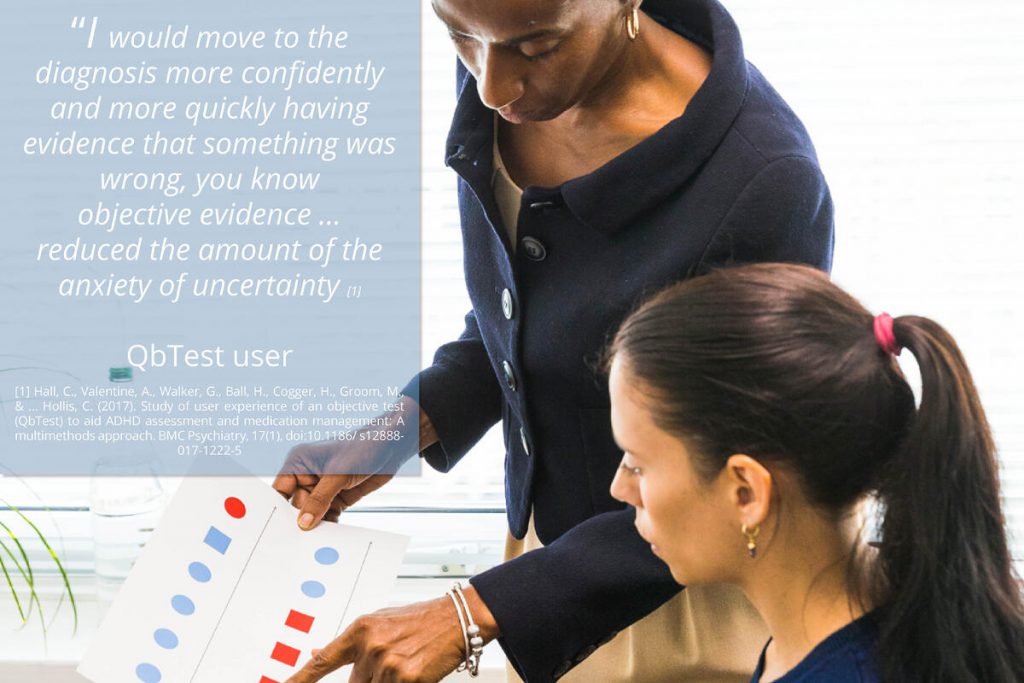ADHD Rating Scales
As a clinician, you will appreciate the value that rating scales add to the ADHD assessment process. You will also know their limitations.
Rating scales like the Swanson, Nolan, and Pelham-IV Questionnaire, Vanderbilt Assessment Scale and ADHD Self-Report Scale are great at taking a snapshot of how symptoms of ADHD present themselves in different environments. Like any other rating scale, however, they are subjective: one person’s view can vary considerably to another person’s view. Likewise, several studies have shown that parent and teacher agreement on symptom ratings range from low to moderate [1].
Adding objective data
The objective ADHD tests QbCheck and QbTest provide a unique insight in the presence or absence of ADHD symptoms. By using a computer-based task combined with activity readings, the tests measure the three core symptoms of ADHD: hyperactivity, inattention and impulsivity. Integrated with rating scales they help delve deeper into the nature of the impairments.

What does it involve?
The computer-based task requires someone to respond to shapes that appear on the computer screen, using a space bar (QbCheck) or a separate responder button (QbTest). Throughout the test responses as well as non-responses are recorded. Meanwhile activity is captured by an infra-red camera (QbTest) or via facial-recognition technology by utilizing the camera in a laptop (QbCheck). This simultaneous measurement is a unique feature of the tests, distinguishing them from other computerized test designed to measure ADHD symptomatology.
Comprehensive results
On test completion, one or more detailed reports are generated instantly, highlighting the individual’s performance across all three core symptom domains and providing an objective view about if/how these symptoms affect them. In both ADHD tests, the individual’s performance is compared with an age and gender matched group of normally developing individuals. In QbCheck, an additional comparison between individuals with a clinical diagnosis of ADHD is made.
The difference between QbTest and QbCheck
QbTest and QbCheck are equivalent tests with regulatory approval (FDA and CE marking) for use in the assessment and treatment follow up of patients with ADHD aged 6 to 60 years old. The tasks within the tests are identical and both tests are available in various languages.
The differences are:
- QbTest requires Qbtech hardware comprising a laptop, responder button, infra-red camera and headband with a marker. QbCheck harnesses the camera in a laptop to track head motion and the space bar for responses, there is, therefore, no hardware required for QbCheck.
- The QbTest report includes 13 parameters and 3 cardinal/summary parameters for hyperactivity, inattention, impulsivity. The QbCheck report includes 5 parameters that cover Hyperactivity, Inattentiveness and Impulsity as well as a Total Symptom Score for ADHD.
- QbCheck includes a rating scale, QbTest does not.
[1] Narad, M. E., Garner, A. A., Peugh, J. L., Tamm, L., Antonini, T. N., Kingery, K. M., Simon, J. O., & Epstein, J. N. (2015). Parent-teacher agreement on ADHD symptoms across development. Psychological assessment, 27(1), 239–248. https://doi.org/10.1037/
